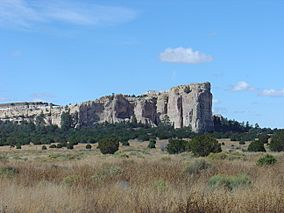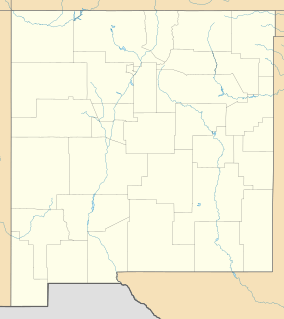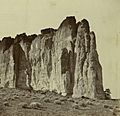El Morro National Monument facts for kids
Quick facts for kids El Morro National Monument |
|
|---|---|
|
IUCN Category III (Natural Monument)
|
|
 |
|
| Location | Cibola County, New Mexico, USA |
| Nearest city | El Morro, New Mexico |
| Area | 1,278.72 acres (5.1748 km2) 1,039.92 acres (420.84 ha) federal |
| Created | December 8, 1906 |
| Visitors | 68,867 (in 2019) |
| Governing body | National Park Service |
| Website | El Morro National Monument |
|
El Morro National Monument
|
|
| Area | 221 acres (89 ha) |
| NRHP reference No. | 66000043 |
| Significant dates | |
| Added to NRHP | October 15, 1966 |
El Morro National Monument is a special place in Cibola County, New Mexico, United States. It's a huge sandstone rock that stands out in the landscape. For hundreds of years, this rock has been a landmark for travelers.
At the base of the rock, there's a natural pool of water. This made El Morro a perfect resting spot in a dry area. Many people who stopped here left their mark by carving messages into the soft sandstone. These messages are still visible today!
Contents
What is El Morro?
El Morro means "The Headland" in Spanish. The local Zuni people call it A'ts'ina, which means "Place of writings on the rock." Early Americans knew it as Inscription Rock. It's a national monument that protects this amazing historical site.
Ancient People and Their Village
Long ago, between about 1275 and 1350 AD, a group of people called the Ancestral Puebloans lived here. Up to 600 people made their home in a large village on top of the mesa. This village had more than 355 rooms!
Their village was on an important ancient trade route. This route connected different communities, like the Zuni and Acoma people. The water at El Morro was vital for everyone traveling this path.
Messages on the Rock: Inscriptions
Because of its water source, El Morro was a natural stopping point for many travelers. They would rest here before continuing their journeys. While resting, many people carved their names, dates, and even short stories into the sandstone cliffs.
Who Left Messages?
The oldest message from a European explorer is from Juan de Oñate. He was the first Spanish governor of the New Mexico colony. His inscription is dated April 16, 1605. Imagine, that's over 400 years ago!
Before the Europeans arrived, the Ancestral Puebloans also left their marks. They carved petroglyphs, which are ancient drawings, into the rocks. These carvings tell stories from centuries ago.
Later, American pioneers and soldiers also added their names. In 1858, members of the Rose-Baley Party, like Leonard John Rose and John Udell, left their signatures.
Protecting the Past
To protect these important historical messages, a U.S. federal law was passed in 1906. This law made it illegal to carve new messages on the cliffs.
President Theodore Roosevelt officially made El Morro a national monument on December 8, 1906. This helped keep the site safe for future generations. In 1966, it was also added to the National Register of Historic Places. Today, the National Park Service takes care of El Morro.
Exploring El Morro Today
When you visit El Morro, you can walk on trails that lead to all the important spots. You can see the many inscription panels, the water pool, and the ruins of the ancient pueblo. There's also a trail that goes to the top of the promontory.
El Morro is part of the Trails of the Ancients Byway. This is a special road that connects many ancient sites in New Mexico. In 2019, El Morro was named an International Dark Sky Park. This means it's a great place to see the stars because the night sky is kept very dark and clear.
Gallery
-
This is the oldest historical inscription at El Morro, carved by Juan de Oñate in 1605.
-
El Morro in 1868, photographed by Alexander Gardner.
See also
 In Spanish: Monumento nacional El Morro para niños
In Spanish: Monumento nacional El Morro para niños









